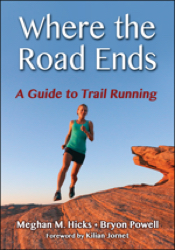
Like this article? Get your copy of the book “Where the Road Ends!”
Welcome to this month’s edition of “Where the Road Ends: A Guide to Trail Running,” where we’re talking about training for trail running.
“Where the Road Ends” is the name of both this column and the book Meghan Hicks and Bryon Powell of iRunFar published in 2016. The book Where the Road Ends: A Guide to Trail Running is a how-to guide for trail running. We worked with publisher Human Kinetics to develop a book offering the information anyone needs to get started, stay safe, and feel inspired with their trail running. The book Where the Road Ends teaches you how to negotiate technical trails, read a map, build your own training plan, understand the basics of what to drink and eat when you run, and so much more.
This column aims to do the same by publishing sections from the book as well as encouraging conversation in the comments section of each article. We want you to feel inspired and confident as you start trail running as well as connected to iRunFar’s community of off-road runners.
In this article, we excerpt from Chapter 8 and talk about training for trail running. If you’re reading this, then chances are you’re interested not only in being a trail runner but also in being a better, stronger, more comfortable trail runner. This article will help you make that happen!
When training for trail running, there are five basic types of workouts used by runners of all kinds:
- easy runs
- recovery runs
- long runs
- speedwork
- hill workouts
These five tools can make any runner better, and each has a distinct purpose. In this article, we discuss easy runs and recovery runs. Click on the links below to dive into the three other parts of this four-part training mini-series:
- Long runs,
- Speedwork, and
- Hill workouts.
Easy Runs
Easy runs are the bread and butter of a trail runner’s training, making up from 70 to 80 percent of it. Their purpose is to build your foundational aerobic capacity and fitness. Max King, who was a Division I All-American steeplechaser and has won road and trail races ranging from five to 100 kilometers in length, advises, “The bulk of your training should be done at a low heart rate between 120 and 150 beats per minute, what’s called the aerobic endurance zone. This is important for fat metabolism, capillary development, oxygen utilization, and so on.”
Easy runs are also just plain enjoyable! We don’t need to overcomplicate what an easy run is: It’s a run that feels easy, in both pace and distance. You should recover from an easy run almost immediately, feeling about the same 15 or 30 minutes after the run as you did before it.
With personal and terrain variations, the pace of an easy run might range from seven to 12 minutes per mile (4.5 to 7.5 minutes per kilometer). Regardless of pace, easy runs should always remain conversational; your effort should allow you to talk easily throughout the run. While trail running, your heart rate can occasionally rise on short hills, but it’s best to scale back your effort on longer hills to keep your heart rate from spiking for more than a minute or two. King notes, “Keeping your heart rate low is what is important and it may require walking to keep it there, especially on a trail run.” His recommendation is to keep your heart rate below 75 percent of its maximum. This is a perfectly legitimate reason to walk a steep or long hill.
The distance of your easy runs varies based on your running history and current goals. It may range from two to 10 miles (three to 16 km). In general, an easy run should not exceed 90 minutes, whatever distance you cover. Vary the time or distance from day to day by making some easy runs shorter and others longer.
Easy runs can take place on any surface, including roads or trails, or some of both in the same run. If you decide to tackle a trail with significant elevation change, be sure to regulate your effort so that the run still feels easy. You’ll also find that trail conditions will dictate your effort. Fresh snow, mud, sand, and rocks, for example, will require more effort than clear, dry trail. When you encounter these conditions, control your effort to keep the run in the easy category.
One of the most common mistakes endurance runners make in their training is running their easy runs at too hard an effort. You might make this mistake for many reasons: You’re running with friends and their pace is faster than your easy-run pace, you feel as if you should be running faster than you are, you encounter bad trail conditions and push through them trying to maintain an even pace, or you just get excited while enjoying a run. Occasionally running your easy runs too fast is okay, but if you do this often enough, you are likely to find that your body performs more poorly during your speedwork and long runs and generally becomes run down, as well. Instead, revel in the fact that your fitness allows your runs to feel easy, and appreciate that you could go much faster. You should feel no shame in running easy.
Recovery Runs
Recovery runs are easy runs taken one step further. That is, they’re one, or sometimes two, gears easier. Although the purpose of an easy run is to have an easy aerobic workout, the purpose of a recovery workout is to increase blood flow into your body’s soft tissues to help them recover from the other more difficult runs you also do in your training, such as your long runs, speedwork, and hill workouts. Those runs have the effect of fatiguing, tightening, and causing microscopic damage to the body’s soft tissues. The recovery run actively aids the body in returning to a healthy status quo.
Like an easy run, a recovery run can vary in pace and distance, but the pacing is slower than that of an easy run. It’s probably slow enough to call it jogging, and that’s alright. When you begin a recovery run, perhaps after a fast run or a race in recent days, your legs may feel sore or heavy. Your goal for a recovery run is to create an experience that allows your body to feel better at the end of the run than it did at the beginning. Perhaps you can channel the thought of “gentle” on your recovery runs. Most experts recommend recovery runs shorter than one hour, usually in the 20- to 30-minute range.
You can do recovery runs on any surface. The soft surfaces of trails are especially helpful for recovery because the soft terrain absorbs some of the impact of your footfalls so that your muscles and joints don’t have to. Some people find that benign, rolling trails make better grounds for a recovery run than trails that are more technical or that have significant elevation change because the latter two types of trails require greater effort to negotiate. Steep climbs and descents can also cause discomfort in sore muscles. A trail on such terrain might be too taxing for a recovery run.
There’s also nothing wrong with taking days entirely off from running. An aching muscle or flagging energy can make such a rest day more useful than an easy run or even a recovery run. On rest days, you can rest completely or, perhaps, do some light cross training.
Excerpted from Where the Road Ends: A Guide to Trail Running, by Meghan Hicks and Bryon Powell. Human Kinetics © 2016.
Call for Comments
- What tips can you share about easy runs and recovery runs?
- What questions do you have about these two types of training?


